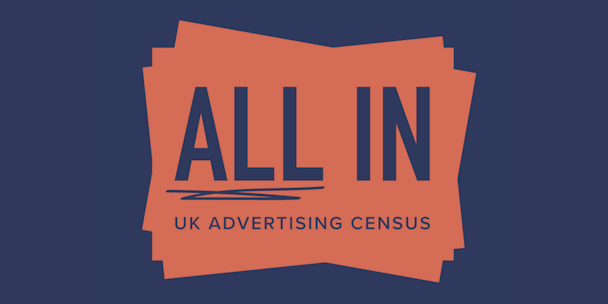A third of Black talent say they’ll leave industry over lack of inclusion, finds AA census
The results of the Ad Association’s (AA) recent All In census reveal disparities among key groups of talent in the advertising industry, leading to the AA issuing three initial calls to action for agencies if they wish to retain diverse talent.

All In plans to tackle the lack of inclusion of Black, disabled and working-class talent
The census surveyed more than 16,000 UK professionals into their experiences in advertising in a landmark survey by the industry’s Inclusion Working Group.
Formed by the AA, IPA and ISBA, the All In census strives to create a more inclusive workplace by highlighting the inequalities within the industry.
Improving the representation of Black, disabled and working-class talent are the first series of actions for the All In campaign, with calls to action including adopting the newly-launched Brim framework, ensuring online accessibility for UK advertising’s websites and using the Social Mobility Commission Toolkit for the Creative Industries, which launches later this month.
Ethnic representation
The results of the census reveal significant divides in the representation of industry workers from ethnic minority backgrounds.
Black talent makes up only 3% of the industry workforce, alongside 7% of Asian talent. At the C-suite level, 3% identify as Asian, and just 1% is composed of Black talent – compared to 3% in the general UK population.
Among the most startling results include reports that a third (32%) of the Black talent in advertising say they’ll leave the industry altogether over lack of inclusion, while 27% of Asian talent said the same.
On these findings, Sharon Lloyd Barnes, the AA’s commercial director, says: “32% of Black people surveyed said they will likely leave our industry because they don’t feel included. The result for Asian talent wasn’t far behind that. This isn’t about the recruitment of Black or Asian people; it’s about changing our industry’s workplace so we can retain this talent.”
Disability
The census also revealed that disabled talent is also significantly underrepresented (just 9% v 20% of the working-age population), with only 6% at the C-Suite level.
Furthermore, 22% of disabled workers say they are likely to leave their organization compared to the industry average of just 9%.
Social mobility and class
Key findings around social mobility in the industry reveal that 28% of UK advertising professionals attended fee-paying schools versus a national average of just 8%.
People from a working-class background are therefore significantly underrepresented, with just 19% of people in the industry identifying as working class, as opposed to 39% of the overall population.
Jemma Garthwaite, chief exec of creative agency This Here, says: “If you look at cultural outlets like the BBC you’ll find that the majority of commissioners are white, public school and/or Oxford University educated. This means their network of shows is ultimately drawn from their own network of contacts with similar backgrounds. Advertising is similar.
“Given that nearly half of all Brits consider themselves working class, how effectively are we really communicating to this half of the country, when such a small percentage of those who work in advertising are from the same background?”
Mental health
Lack of diversity, inclusivity, and accountability within the industry might also be traced as a leading cause of poor mental health among ad industry workers, as the survey also reveals that 31% of respondents have reported feeling unnecessarily stressed or anxious.
Among those from marginalized communities, these numbers start to climb, with 51% of disabled respondents reporting that their mental health has suffered at work, alongside 45% of workers who identify as LGBT+.
Call to action
Many in the industry feel that these results will serve as a wake-up call to the work agencies will now need to do if they wish to hire and retain diverse talent.
Anna Dalziel, senior vice-president and director of marketing communications at Momentum Worldwide, says: “It’s widely acknowledged that businesses who create a safe, welcoming and open culture thrive in all aspects. We need to look not only at the routes currently used to advertise roles, but identify the barriers stopping people applying.”
She says that going forward, “we need to understand what’s happening within agencies to increase retention and allow everyone to progress. Honest conversations need to happen, action needs to be taken and we need to ensure we are accountable. We’ve found by partnering with associations such as Adfellows, Creative Equals and The 3% Movement, changes are taking place that are making the industry a more inviting sector to join and stay working in. There isn’t one solution to solve DE&I, there are many.”
The All In Report has pinpointed key actions for the industry to make swift progress, specifically improving the experience and representation of Black talent through the rapid adoption of the newly-launched Brim framework.
In order to support disabled professionals, the AA recommends the immediate audit of websites across the industry to ensure full accessibility online.
To encourage the mobility of talent from working-class backgrounds, the AA suggests uptake of the Social Mobility Commission Toolkit for the Creative Industries, which launches later this month.
In addition, a comprehensive directory of inclusion schemes and initiatives that can be accessed by companies in the UK advertising industry has been compiled by the Inclusion Working Group. The All In Directory has details on how to recruit, support and advance talent.

